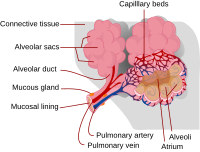
Photo from wikipedia
The respiratory system plays an essential role for human life. This system (like all others) undergoes physiological regeneration due to many types of stem cells found both in the respiratory… Click to show full abstract
The respiratory system plays an essential role for human life. This system (like all others) undergoes physiological regeneration due to many types of stem cells found both in the respiratory tract itself and in the alveoli. The stem cell hierarchy is very extensive due to their variety in the lungs and is still not completely understood.The best described lung stem cells are alveolar type II cells, which as progenitor lung stem cells are precursors of alveolar type I cells, i.e., cells that perform gas exchange in the lungs. These progenitor stem cells, which reside in alveoli corners, express high levels of surfactant protein C (SFTPC). Despite the fact that type II pneumocytes occupy only 7-10% of the lung surface, there are almost twice as many as alveolar type I cells occupying almost 95% of the surface.Other stem cells making up the lung regenerative potential have also been identified in the lungs. Both endothelial, mesodermal, and epithelial stem cells are necessary for the lungs to function properly and perform their physiological functions.The lungs, like all other organs, undergo an aging process. As a result of this process, not only the total number of cells changes, the percentage of particular types of cells, but also their efficiency is reduced. With age, the proliferative potential of lung stem cells also decreases, not just their number. This brings about the need to increase the intensity of research in the field of regenerative medicine.
Journal Title: Advances in experimental medicine and biology
Year Published: 2019
Link to full text (if available)
Share on Social Media: Sign Up to like & get
recommendations!